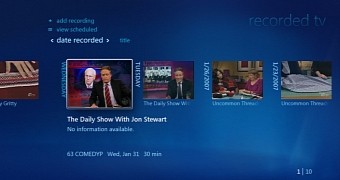Microsoft has decided to launch Windows 10 without a Media Center edition and thus discontinue the version that was first introduced in 2002 with Windows XP in order to give users more control over their multimedia content.
Microsoft executives reportedly confirmed at BUILD 2015 that Windows Media Center was no longer part of company's plans, so the version the software giant launched in 2009 for Windows 7 users was pretty much the last one we got.
Windows Media Center was launched 13 years ago for Windows XP and offered remote control of media playback on a Windows XP computer. It was then updated as part of the next Windows releases, with Microsoft rolling out the latest full version in 2009 for Windows 7 users.
The team that worked on Windows Media Center split after the 2009 release, so for Windows 8, Microsoft only released an add-on providing the same features as in Windows 7. There were no new features, no improved UI, and no performance enhancements, with Microsoft clearly stating at that time that Windows Media Center wasn't part of its future plans.
And with Windows 10, the company is finally killing this piece of software, most likely because the new operating system already includes advanced features and tools that can provide similar functionality.
Very low usage
According to Microsoft, only few people continue to use Windows Media Center on their computers, and company executives previously stated that it made less sense to continue development of the software because only few users were actually getting it.
Steven Sinofsky, the man in charge of Windows 8, who stepped down just after the launch of the new OS in late 2012, also revealed that launching a Media Center edition for Windows 8 was canceled because of the decreasing interest in such a version.
With Windows 10, Microsoft won't offer dedicated features to replace Media Center, but instead will encourage users to purchase Xbox gaming consoles that offer similar functionality and provide both live and on-demand content in the living room.
Xbox One, which will be based on Windows 10 software, is becoming Microsoft's main device not only for gaming but also for video and TV shows content, and comes with Blu-ray playback, OneGuide to combine live TV with apps running on the console, and motion control with the help of Kinect, so it could become the main living room device for anyone moving to the new OS version.

 14 DAY TRIAL //
14 DAY TRIAL //